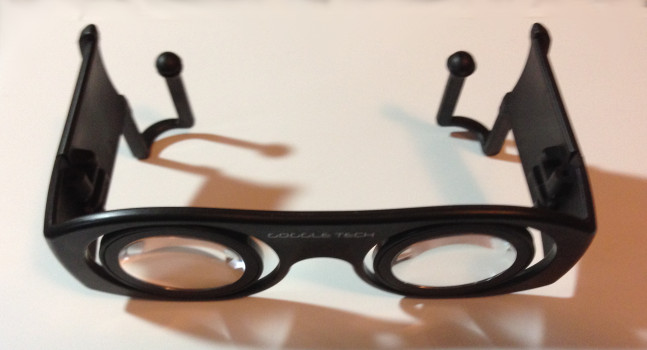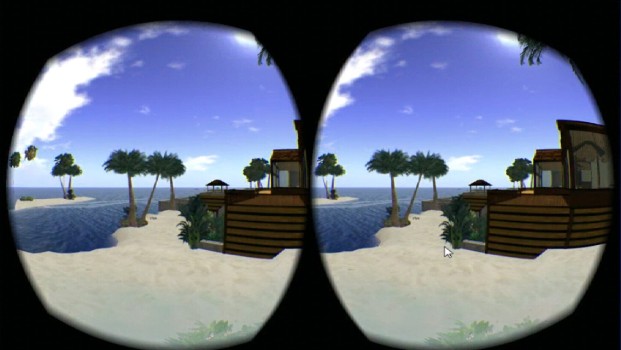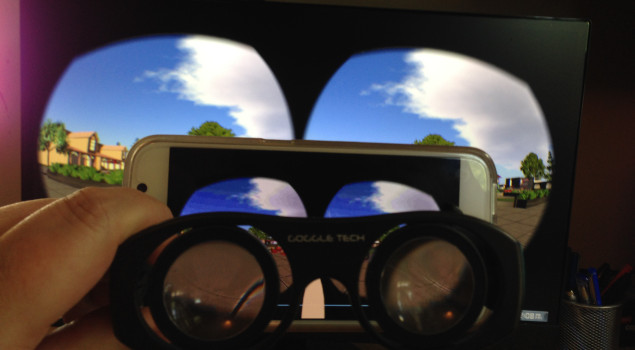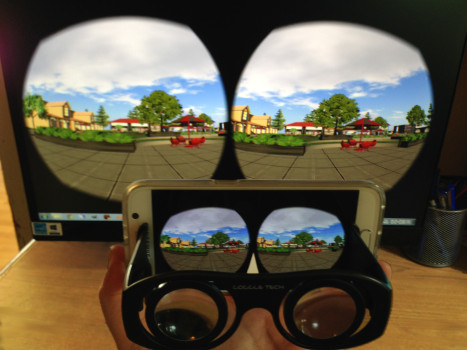As my regular readers know, I’ve been trying to use a smartphone-and-Cardboard combo as an Oculus Rift replacement so that I could walk around my OpenSim builds without having to shell out $350 for the Oculus development kit.
It’s not that I’m cheap — okay, yes, I’m cheap — but I don’t want to spend $350 now, then spend that amount again when the consumer version comes out next year. Plus, there isn’t that much content out there yet for the Oculus Rift.
Meanwhile, a virtual reality case for a smartphone is cheap — there are several options that cost under $10 — and my current favorite headset costs just $22.

Note that I’m not actually running an OpenSim viewer on my smartphone. All I’m doing is using it as an external monitor and input device. I still need to have a desktop PC running OpenSim itself.
In order to use a smartphone as an Oculus Rift-style peripheral, you need three things:
- A viewer that can turn a standard view of your OpenSim build into a side-by-side stereoscopic view
- A way to mirror your desktop view on your smartphone
- A way to track the direction your smartphone is pointed
Previously, I was only able to get the first two parts to work. This allowed me to get a 3D view onto my iPhone, but not to move my head to look in different directions.
Since then, I switched to an Android phone, the Samsung Galaxy S6, and have repeatedly tried to get it to work with no success. Until now.
Here is what I did.
Side-by-side view
To tour OpenSim — or Second Life — in immersive virtual reality you need to be running a viewer that supports side-by-side views.
If you’re just looking at Second Life, Linden Lab has a Project Oculus Rift Viewer. But since I want one that works in both OpenSim and Second Life, I use the CtrlAltStudio Viewer.
Unfortunately, the latest version crashes immediately if you don’t have an actual Oculus Rift connected.
This is a known problem. Unfortunately, don’t expect a fix to come anytime soon.
“This viewer is intimately tied in with the Oculus Rift SDK code,” said developer David Rowe in his response. “Unfortunately I don’t have the equipment or time to sort out Google Cardboard support. Sorry.”
I was able to get around this by loading the previous version of the CtrlAltStudio Viewer instead, version 1.2.3.42797 Alpha.

Here are the important settings:
Preferences>Graphics>General
- Fullscreen Mode is off
- Advanced Lighting Model is on
Preferences>Graphics>Hardware Settings
- Antialiasing is on
Preferences>Graphics>Rendering
- Limit Framerate is off
Preferences>Graphics>Display Output
- Oculus Rift is on
- Mouse moves view, Alt-mouse moves cursor is on
I didn’t play around with with any of the quality settings, except to reduce everything down to the minimum.
Click here for more info about configuring the CtrlAltStudio Viewer.
Connecting the smartphone
I used TrinusVR to connect my smartphone to my desktop, both for mirroring the display and for the headtracking. You will need two separate programs for this — and both are free.
Download the TrinusVR PC Server here.
Download TrinusVR Lite for Android here. The free lite version says it has a limit of 15 minutes per session — the full, unlimited version is $5.
Definitely get the Lite version first. As a side note, TrinusVR can also be used to play PC games like Skyrim in immersive virtual reality as well with just your smartphone.
There’s a choice between WiFi tethering and USB tethering. USB tethering is supposed to be faster, but you’ll have to have the phone plugged into its USB cord. WiFi tethering is wireless.
I tried it both ways, it was slow either way. To get USB tethering to work on my phone, I had to disable the WiFi, and enable USB tethering in the settings. On my phone, the USB tethering was under the “More” category in Settings.
To get it working:
- I ran the CtrlAltStudio Viewer — ignored the warnings about the Oculus Rift not being connected — and logged into my grid.
- I ran the TrinusVR desktop application.
- I ran the TrinusVR Android application.
- I hit the start buttons on both of the TrinusVR apps until my smartphone screen switched to a mirror of my desktop screen — showing the other TrinusVR app window.
- IÂ clicked on the CtrlAltStudio Viewer icon on my Windows bar to switch to the viewer. Now both my desktop monitor and my phone showed a regular view of my grid.
- I clicked on the “3D” button on the bottom of my CtrlAltViewer screen. You might need to customize your bottom toolbar to have that button show up — I can’t remember now if I did that or not, or if the button shows up there automatically. Ctrl+Alt+3 is the keyboard shortcut.
- I put the phone in the virtual reality headset and put it on. Turning my head let me look in different directions.
- I used the arrow keys to move around.
For the headset, I used my favorite Goggle Tech glasses. As a benefit, since the Goggle Tech glasses are open-sided, they didn’t block my view of the keyboard.

Possible use cases
I can see architects or landscape designers or civil engineers using OpenSim as a fast prototyping tool, and using this setup to allow customers to look around the proposed build.
This would allow the builder to make changes to the environment on the fly.
I can also see this used in schools, allowing students to go inside their virtual builds or into third-party simulations at an extremely low cost.
Challenges
Currently, the best way to move around inside a virtual environment without getting nauseous is click-to-teleport. However, when you’re in mouselook view, this can be tricky to implement.
The experience is also pretty laggy, though I’m sure that this will improve as the technology gets faster. Smartphones, in particular, are evolving very quickly.
My image quality was also very low, but then again, I did have it set to the lowest settings. I might need to play around with it to get it to work. Menus are hard to navigate.
Finally, for whatever reason, using my smartphone with OpenSim didn’t feel as immersive as some of the other virtual reality apps I’ve tried. Maybe my field of depth or other settings were misconfigured. I’ll also need to try my other headsets, see if they work better.  I’m also looking forward to seeing Bright Canopy support for mobile devices and for the CtrlAltStudio Viewer.
But all in all, I’d say that OpenSim is currently not a killer app for smartphone-based virtual reality. I’d have to say that probably porn is, followed by watching immersive videos and playing casual virtual reality games.
- OSgrid back online after extended maintenance - April 16, 2025
- Analysts predict drop in headset sales this year - March 25, 2025
- OSgrid enters immediate long-term maintenance - March 5, 2025

